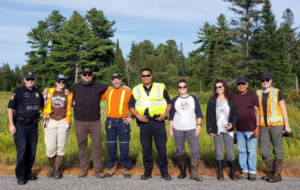Magnetawan First Nation holds successful Turtle Release initiative

By Curtis Avery
MAGNETAWAN FIRST NATION— On September 12, 2019, the Anishinabek Nation was invited to participate in a Turtle Release initiative held by Magnetawan First Nation (MFN). The event was one of many that took place throughout September as part of the First Nation’s Species at Risk (SAR) Program.
It is to no surprise that now, all eight of Ontario’s turtle species are at risk of disappearing from the province. Characterised by their slow growing and late maturing life history strategies, their populations can be greatly impacted by mortalities. One of the greatest threats currently facing turtles are roadways. A great number of turtles are killed on the roadway every year, this is exacerbated by the fact that roadside shoulders often encourage the migration of female turtles to nest in these granular substrates. In some cases, like the Blanding Turtle, these nests are virtually impossible to detect, and are thus susceptible to mortality during the road construction and maintenance season. These newly hatched turtles face the massive threat of traffic, in addition to natural predators. This can be detrimental to turtle populations considering that the turtle nesting season often range from June, emerging into October.
MFN is located in the heart of the Georgian Bay Biosphere. This special environment stretches approximately 175 kilometres and consists of shoreline and inland areas, from the French River to the Severn River of Georgian Bay. The area is characterised by the rich and diverse ecology, habitat and wildlife; including some 50 species at risk. As stewards of the land, the MFN’s Lands and Resources Department has been steadily engaged in a Species at Risk program, aimed at the preservation and rehabilitation of turtle populations within the community’s traditional territory. They are funding recipients of the Indigenous and Northern Affairs Canada Indigenous Community-Based Climate Monitoring Program and as of 2019, part of the Indigenous Guardians Network. Today, an increasing amount of motor vehicle traffic and northern road expansion projects continue to impact turtle populations in the area. Environmental Management Biologist Cory Kozmik heads the SAR program in MFN. Some initiatives that the department and its SAR program is working on include:
- Road, rail and population surveys for gathering relative species abundance, distribution and mortality estimates
- Turtle first responders for injured turtles
- Turtle nest protection (clutch removal, incubation and release)
- Climate change and traditional resource monitoring
- SAR training for industry, including transportation and energy
- Baseline monitoring
- Environmental construction monitoring
- Integrating Traditional Knowledge with Western Science into research and management

A large proportion of the Species at Risk program is geared towards reducing turtle road mortality. This year, the SAR team collected approximately 700 eggs. Eggs were incubated, raised and then released to nearby wetlands to give the young turtles a head start. The future looks optimistic given the program’s success, positive feedback and praise received from nearby communities, organizations and stakeholders. MFN leadership and citizens are actively participating in these ongoing stewardship, research and conservation initiatives. The Anishinabek Nation and its member First Nations look forward to the future successes of the program, and the valuable lessons it has to offer for the rest of the Nation and Ontario.

